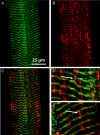The accessibility and interconnectivity of the tubular system network in toad skeletal muscle
- PMID: 18772207
- PMCID: PMC2652160
- DOI: 10.1113/jphysiol.2008.155127
The accessibility and interconnectivity of the tubular system network in toad skeletal muscle
Abstract
The tubular (t) system is essential for normal function of skeletal muscle fibre, acting as a conduit for molecules and ions within the cell. However, t system accessibility and interconnectivity have been mainly assessed in fixed cells where the t system no longer fully represents that of the living cell. Here, fluorescent dyes of different diameter were allowed to equilibrate within the t system of intact fibres from toad, mechanically skinned to trap the dyes, and then imaged using confocal microscopy to investigate t system accessibility and interconnectivity. Dual imaging of rhod-2 and a 500 kDa fluorescein dextran identified regions throughout the t system that differed in the accessibility to molecules of different molecular weight. Restrictions within the t system lumen occurred at the junctions of the longitudinal and transverse tubules and also where a transverse tubule split into two tubules to maintain their alignment with Z-lines of adjacent mis-registered sarcomeres. Thus, three types of tubule, transverse, longitudinal and Z, can be identified by their lumenal diameter in this network. The latter we define for the first time as a tubule with a narrow lumen that is responsible for the change in register. Stretch-induced t system vacuolation showed exclusive access of rhod-2 to these structures indicating their origin was the longitudinal tubules. Exposing the sealed t system to highly hypertonic solution reversed vacuolation of longitudinal tubules and also revealed that these tubules are not collapsible. Fluorescence recovery after photobleaching (FRAP) measurements of t system-trapped fluo-5 N showed interconnectivity through the t system along the axis of the fibre. However, diffusion occurred at a rate slower than expected given the known number of longitudinal tubules linking adjacent transverse tubules. This could be explained by the observed narrow opening to the longitudinal tubules from transverse tubules, reducing the effective cross-sectional area in which molecules could move within the t system.
Figures







Similar articles
-
Osmotic properties of the sealed tubular system of toad and rat skeletal muscle.J Gen Physiol. 2004 Mar;123(3):231-47. doi: 10.1085/jgp.200308946. J Gen Physiol. 2004. PMID: 14981135 Free PMC article.
-
Three-dimensional reconstruction and analysis of the tubular system of vertebrate skeletal muscle.J Cell Sci. 2013 Sep 1;126(Pt 17):4048-58. doi: 10.1242/jcs.131565. Epub 2013 Jun 26. J Cell Sci. 2013. PMID: 23813954
-
Properties of the vertebrate skeletal muscle tubular system as a sealed compartment.Cell Biol Int. 2002;26(10):921-9. doi: 10.1006/cbir.2002.0942. Cell Biol Int. 2002. PMID: 12421583
-
Reversible vacuolation of T-tubules in skeletal muscle: mechanisms and implications for cell biology.Int Rev Cytol. 2001;202:243-98. doi: 10.1016/s0074-7696(01)02006-x. Int Rev Cytol. 2001. PMID: 11061566 Review.
-
[Functional role of vacuolization of the T-system of skeletal muscle fibers].Tsitologiia. 1997;39(10):878-88. Tsitologiia. 1997. PMID: 9505335 Review. Russian.
Cited by
-
Examination of the subsarcolemmal tubular system of mammalian skeletal muscle fibers.Biophys J. 2013 Jun 4;104(11):L19-21. doi: 10.1016/j.bpj.2013.04.029. Biophys J. 2013. PMID: 23746530 Free PMC article.
-
Localized nuclear and perinuclear Ca(2+) signals in intact mouse skeletal muscle fibers.Front Physiol. 2015 Sep 29;6:263. doi: 10.3389/fphys.2015.00263. eCollection 2015. Front Physiol. 2015. PMID: 26483696 Free PMC article.
-
A quantitative description of tubular system Ca(2+) handling in fast- and slow-twitch muscle fibres.J Physiol. 2016 Jun 1;594(11):2795-810. doi: 10.1113/JP271658. Epub 2016 Feb 29. J Physiol. 2016. PMID: 26775687 Free PMC article.
-
Quantitative measurement of Ca²(+) in the sarcoplasmic reticulum lumen of mammalian skeletal muscle.Biophys J. 2010 Oct 20;99(8):2705-14. doi: 10.1016/j.bpj.2010.08.032. Biophys J. 2010. PMID: 20959112 Free PMC article.
-
Longitudinal and transversal propagation of excitation along the tubular system of rat fast-twitch muscle fibres studied by high speed confocal microscopy.J Physiol. 2012 Feb 1;590(3):475-92. doi: 10.1113/jphysiol.2011.221796. Epub 2011 Dec 12. J Physiol. 2012. PMID: 22155929 Free PMC article.
References
-
- Crank J. The Mathematics of Diffusion. 2nd edn. Oxford: Clarendon Press; 1976.
-
- DiFranco M, Capote J, Vergara JL. Optical imaging and functional characterization of the transverse tubular system of mammalian muscle fibers using the potentiometric indicator di-8-ANEPPS. J Membr Biol. 2005;208:141–153. - PubMed
-
- Eisenberg BR. Quantitative ultrastructure of mammalian skeletal muscle. In: Peachey LD, editor. Handbook of Physiology, section 10, Skeletal Muscle. Bethesda, MD, USA: American Physiological Society; 1983. pp. 73–112.
Publication types
MeSH terms
Substances
LinkOut - more resources
Full Text Sources
Miscellaneous

